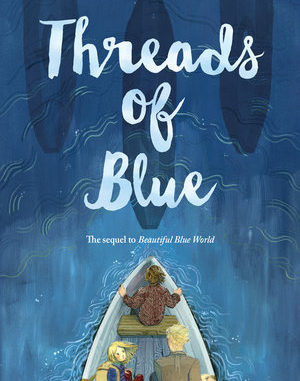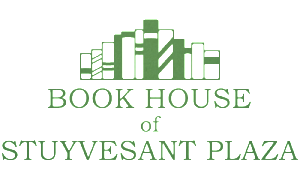
 As part of our ongoing collaboration with the Book House of Stuyvesant Plaza, our writers have accepted the challenge of reading and reviewing pre-publication review copies of highly anticipated young adult literature. The reviews are posted here for our readers, but also will be sent to the Book House where they will hopefully be used to inform customers about the books they may want to purchase.We will try to publish one review a week for the spring.
As part of our ongoing collaboration with the Book House of Stuyvesant Plaza, our writers have accepted the challenge of reading and reviewing pre-publication review copies of highly anticipated young adult literature. The reviews are posted here for our readers, but also will be sent to the Book House where they will hopefully be used to inform customers about the books they may want to purchase.We will try to publish one review a week for the spring.
The reviews contain spoilers, so be forewarned!
Threads of Blue
by Suzanne LaFleur
Published September 2017
224 pages, Wendy Lamb Books
The book Threads of Blue, by Suzanne LaFleur, sequel to Beautiful Blue World, is about a young girl named Mathilde who flees her country after it was invaded. Mathilde meets many new people and makes a lot of new friends on her journey. The book begins with Mathilde arriving at a foreign nation on a fishing boat, “I had never been to Eilean. I would set foot in a new country for the first time.” (4). Since she passed a military aptitude test, Mathilde was chosen to fight for her country, called Sofarende, at a very young age, “If you’d passed the test, you spend the rest of the war in the army. But they’d taken us from the bombed cities, kept us safe and fed. It was what my parents hoped for.” (6). Mathilde, like her friends, escaped the war and is fleeing to safety. The book shows the effects of war on children, most of which are negative, including the destruction of homes, and the loss of family and friends. Another theme of the book is the hardships people go through when they immigrate to a foreign nation, “We walked, and slept in barns, and town squares. We walked, and I stole two coats from an empty house. We walked, and ate acorns from the woods.” (186). A turning point of the book is the heartwarming moment when Mathilde finally unites with her best friend, named Megs, after they lost each other in the turmoil of war, “’I love you,’ I said. Saying it was easy. True. ‘I came to get you. Come with me.’” (198).
…it is hard to be a refugee in a country you have never been to before
Suzanne LaFleur made interesting stylistic choices when she wrote Threads of Blue. The author uses different literary devices throughout the book. At the beginning of the book, the author uses paradoxes like Mathilde thinking that she is dead. This is a paradox because dead people cannot think. Then, in chapter 34 the author uses repetition to make this noticeably shorter chapter seem very important. The author’s message is that it is hard to be a refugee in a country you have never been to before. In chapter 34, again one of the more important chapters, the main idea is how hard it is to be a refugee. The repetition of the words “we walked” show that refugees are always walking because they do not have a home. This chapter also gives examples of some of the hardships that refugees face, such as having nowhere to sleep, having almost no personal possessions, and having nothing to eat. In chapter 35, the author uses italics to show that Mathilde is dreaming. This is important because it shows what the main character desires. This chapter shows how important Mathilde’s father is because she dreams about reconnecting with him. This is a very good writing strategy because it lets the reader connect more to the character and understand what the character is feeling. Italics differentiate the dream from the normal course of the book, thus making it appear very important. The author uses literary devices and stylistic choices such as paradoxes, repetition, and italics to add an interesting style to her work, and to show what ideas in the book are more important than others.
Overall, I honestly did not really like Threads of Blue by Suzanne LaFluer. It might be because the book is a sequel, and I never read the first one. This left me confused when Threads of Blue book referred back to Beautiful Blue World. For example, Mathilde talked about her parents at the beginning of the book and there was no clear explanation of what happened to them. I feel like I would like the book more, and understand it better, if I had read Beautiful Blue World before Threads of Blue. I also do not like the plot of Threads of Blue very much. A story about a girl leaving a fictional country because of a war, and trying to adapt and survive in a new home, does not really connect with me or my interests. On the other hand, I felt the message to be very explicit and genuinely good. There are many refugees in America from Mexico, Syria, and other countries. This strong message could definitely inspire them because it relates to their lives, and attempts to help make them feel better about their situation by showing them that they are not alone. I think that the author intended to give refugees hope and show them that they are not alone, which is very noble and nice. Threads of Blue also has a main theme of friends and family, which is another very nice theme. Mathilde is searching for her friends and family throughout the whole book and finally finds her best friend near the end of the book. The author uses pathos, the appeal to the audience’s emotions, to make her audience feel bad for Mathilde because of all the loved ones she has lost. This hooks the reader in more closely, and gives the book more depth. I did not enjoy the plot very much, there were a few plot twists that I enjoyed, but I could not connect with the book very well. This could be because I do not understand it, since I have not read Beautiful Blue World, or it could be because I just could not connect with the main character on a personal level because I have never experienced her situation and do not understand how she feels. The author could have done a better job explaining Mathilde and the other characters’ emotions throughout the book, that probably would have allowed me to connect with them more and understand them better. This could improve the way the author delivered her message and therefore make her book much better and more interesting. I feel that Threads of Blue was a successful book overall because it achieved its purpose and conveyed its message very clearly, but I personally did not like the way the author delivered her message.
